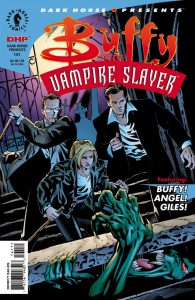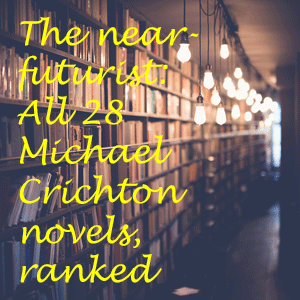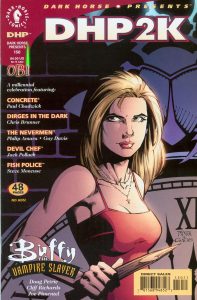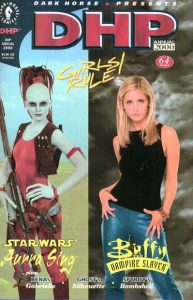In addition to the main “Buffy” series and its miniseries and one-shots, Dark Horse put out several short tales about the Slayer in its early days with the license. The main outlet for these yarns was “Dark Horse Presents,” a monthly black-and-white comic that served as a way to advertise the company’s titles and get current fans to buy another comic – something that obviously worked on me. “DHP” delivered four comics containing “Buffy” stories from 1998-2000; here’s a closer look:
“MacGuffins” (“DHP” Annual 1998, September 1998)
The very first “Buffy” comic story, weirdly, is headed by two people who would never do another: writer J.L. Van Meter and penciller Luke Ross, who draws an excellent, if leggy, Buffy. (Inker Rick Ketcham would go on to several “Buffy” projects.) Hidden inside an issue with a “Hellboy” cover, it’s set at Buffy’s dad’s house in the summer after sophomore year – a setting that would later be contradicted by the short-story collection “How I Survived My Summer Vacation,” wherein Hank lives in an apartment.
Annoyed by houseflies, Buffy gets another annoyance when she receives a box containing the two titular gremlins that tear through the house. On the phone, Giles informs her they are indeed mere annoyances, not threats. The kicker is that Giles sent the creatures as a test to keep his vacationing Slayer sharp, making the yarn a much more playful answer to “Helpless” (3.12).
This story was later colored, and you can find that version at Dark Horse’s website.
3 stars

“Dark Horse Presents” No. 141 (March 1999)
Fans will get the most bang for their buck from this all-“Buffy” issue. All three tales are from members of the “BTVS Classic” team, so there’s not much new talent to discover here, except for inks by Jim Amash on “Hello, Moon” and pencils by David Perrin on “Dead Love” (He does a good Giles and Buffy but misses on Angel).
The most interesting of the three is Christopher Golden’s “Cursed.” It’s a straightforward “Angel is tortured by his past” yarn – a precursor to what Golden would explore in “Angel: The Hollower” — but what makes it interesting is the elements that the TV show would later contradict. Golden figures Angel has always been named Angel, with Angelus being his full name. In “The Prodigal” (“Angel” 1.15), we learn that Angel’s human name was Liam. Coincidentally, the human Angel’s best friend is named Liam in “Cursed.”
In “Hello, Moon” by Dan Brereton and Golden, Buffy encounters a fish monster on the beach who turns out to not be evil, and he’s a chosen one among his own species. He looks similar to the creatures from “Go Fish” (2.21), but there’s no connection beyond that. In “Dead Love” by Andi Watson, Giles thwarts a “Frankenstein”-style reanimation plot.

3 stars

“Killing Time” (“DHP” No. 150, January 2000)
This has the best cover of these four issues – a shadowy hero pose by Randy Green (pencils), Andy Owens (inks) and Guy Major (colors). As for the story, let’s just say it won’t be at the top of the resume of Doug Petrie, one of the best and most prolific TV writers in the Whedonverse. In Season 4, some UC-Sunnydale sorority pledges resurrect a demon in the school’s clock tower. The way Buffy defeats it is worth a smirk – the arrogant “elemental” can turn into anything, so she challenges it to turn into a bug, which she then defeats with bug spray – but otherwise this is insubstantial.
2.5 stars

“Take Back the Night” (“DHP” Annual 2000, June 2000)
Buffy shares cover-girl status with “Star Wars’ ” Aurra Sing in this issue. Although “Aurra’s Song” actually is essential, the “Buffy” tale from “BTVS Classic” regulars Tom Fassbender and Jim Pascoe is not. A demon that can turn into swarms of flies attacks women at UC-Sunnydale in this early Season 4 yarn that’s even thinner than “Killing Time.” A member of the Initiative is a womanizer. Buffy kills the demon, but doesn’t tell the Initiative soldiers who she is, as that is to be saved for later.
2 stars
Click here for an index of all of John’s “Buffy” and “Angel” reviews.

